Googling Fashion: Forecasting Fashion Consumer Behaviour Using Google Trends
Abstract
1. Introduction
2. Googling Fashion
2.1. How is the Fashion Industry Exploiting Google Trends?
2.2. How Can Google Trends Help Strategic Fashion Management & Marketing Decisions?
2.2.1. Identifying Seasonal Patterns in Demand
2.2.2. Competitor Analysis
2.2.3. Identifying Brand Extension Opportunities
2.2.4. Identifying Better Marketing Terms
3. Data
Burberry Google Trends
4. Forecasting Models
4.1. Autoregressive Integrated Moving Average (ARIMA)
4.2. Exponential Smoothing (ETS)
4.3. Trigonometric Box–Cox ARMA Trend Seasonal Model
4.4. Neural Network Autoregression (NNAR)
4.5. Denoised Neural Network Autoregression (DNNAR)
5. Empirical Results
6. Discussion
6.1. Are Web Searches for Burberry Predominantly Generated by Online Fashion Consumers who are Looking to Shop?
6.2. Google Trends vs. Trend Forecasting Giants (Edited & WGSN)
7. Conclusions
Author Contributions
Funding
Acknowledgments
Conflicts of Interest
References
- Armstrong, Paul. 2016. Why Your Business Should Be Using Google Trends. Available online: https://www.forbes.com/sites/paularmstrongtech/2016/04/01/why-your-business-should-be-using-google-trends/#4495c66d8268 (accessed on 22 July 2018).
- Au, Kin-Fan, Tsan-Ming Choi, and Yong Yu. 2008. Fashion retail forecasting by evolutionary neural networks. International Journal of Production Economics 114: 615–30. [Google Scholar] [CrossRef]
- Bae, Su Yun, Nancy Rudd, and Anil Bilgihan. 2015. Offensive advertising in the fashion industry: Sexual objectification and ethical judgments of consumers. Journal of Global Fashion Marketing 6: 236–49. [Google Scholar] [CrossRef]
- Bain, Marc. 2016. Google Already Knows the Fashion Trends that Will Be Popular this Fall. Available online: https://qz.com/767643/google-already-knows-the-fashion-trends-thatll-be-popular-this-fall/ (accessed on 22 July 2018).
- Bain, Marc. 2018. Burberry Won’t Burn Unsold Goods Anymore, but What about the Brands that didn’t Get Caught? Available online: https://qz.com/quartzy/1381150/burberry-wont-burn-unsold-goods-anymore-but-what-about-everyone-else/ (accessed on 24 March 2019).
- Bangwayo-Skeete, Prosper F., and Ryan W. Skeete. 2015. Can Google data improve the forecasting performance of tourist arrivals? Mixed-data sampling approach. Tourism Management 46: 454–64. [Google Scholar] [CrossRef]
- BBC. 2018. Burberry Burns Bags, Clothes and Perfume Worth Millions. Available online: https://www.bbc.co.uk/news/business-44885983 (accessed on 11 March 2019).
- BBC. 2019. Boohoo Remains in Fashion as Sales Surge. Available online: https://www.bbc.co.uk/news/business-46874367 (accessed on 19 February 2019).
- Bloomberg. 2017. Google Searches Seen as Luxury Investors’ Must-Have Tool in Fashion. Available online: https://www.businessoffashion.com/articles/news-analysis/google-searches-seen-as-luxury-investors-must-have-tool-in-fashion (accessed on 17 March 2019).
- Bobila, Maria. 2017. Chinese Retail giant Alibaba Launches ‘Big Data Anti-Counterfeiting Alliance’ with Louis Vuitton, Swarovski and More. Available online: https://fashionista.com/2017/01/alibaba-anti-counterfeit-alliance (accessed on 3 February 2019).
- Boone, Torrence. 2016. Fashion Trends 2016: Google Data Shows What Shoppers Want. Available online: https://www.thinkwithgoogle.com/advertising-channels/search/fashion-trends-2016-google-data-consumer-insights/ (accessed on 14 February 2019).
- Boone, Tonya, Ram Ganeshan, Robert L. Hicks, and Nada R. Sanders. 2017. Can Google Trends Improve your Sales Forecast? Production and Operations Management 27: 1770–74. [Google Scholar] [CrossRef]
- Box, George Edward Pelham, and Gwilym Jenkins. 1970. Time Series Analysis: Forecasting and Control. San Francisco: Holden-Day. [Google Scholar]
- Bradlow, Eric Thomas, Manish Gangwar, Praveen Kopalle, and Sudhir Voleti. 2017. The Role of Big Data and Predictive Analytics in Retailing. Journal of Retailing 93: 79–95. [Google Scholar] [CrossRef]
- Broomhead, David S., and Gregory P. King. 1986a. Extracting qualitative dynamics from experimental data. Physica D: Nonlinear Phenomena 20: 217–36. [Google Scholar] [CrossRef]
- Broomhead, David S., and Gregory P. King. 1986b. On the qualitative analysis of experimental dynamical systems. In Nonlinear Phenomena and Chaos. Edited by Sarben Sarkar. Bristol: Adam Hilger, pp. 113–44. [Google Scholar]
- Brown, Robert Goodell. 1959. Statistical Forecasting for Inventory Control. New York City: McGraw/Hill. [Google Scholar]
- Brown, Indya. 2016. Watch Burberry’s First See-Now, Buy-Now Collection Live. Available online: https://www.thecut.com/2016/09/watch-burberrys-first-see-now-buy-now-collection-live.html (accessed on 11 March 2019).
- Bulut, Levent. 2018. Google Trends and the forecasting performance of exchange rate models. Journal of Forecasting 37: 303–15. [Google Scholar] [CrossRef]
- Burberry. 2018a. Strategic Report. Available online: https://www.burberryplc.com/content/dam/burberry/corporate/Investors/Results_Reports/2018/Burberry_AnnualReport_FY17-18.pdf (accessed on 11 March 2019).
- Burberry. 2018b. Burberry Ends Practice of Destroying Unsaleable Products. Available online: https://www.burberryplc.com/en/news-and-media/press-releases/corporate/2018/burberry-ends-practice-of-destroying-unsaleable-products.html (accessed on 11 March 2019).
- Burberry. 2019. History. Available online: https://www.burberryplc.com/en/company/history.html (accessed on 16 March 2019).
- Choi, Hyunyoung, and Hal Varian. 2012. Predicting the present with Google Trends. Economic Record 88: 2–9. [Google Scholar] [CrossRef]
- Cusick, Ashley. 2016. Burberry Breaks All the Rules at London Fashion Week. Available online: http://www.essentialjournal.co.uk/burberry-breaks-all-the-rules-at-london-fashion-week/ (accessed on 11 March 2019).
- D’Arpizio, Claudia, and Federica Levato. 2017. The Millennial State of Mind. Available online: https://farfetch.prezly.com/bain--company-media-pack (accessed on 11 March 2019).
- De Livera, Alysha M., Robin John Hyndman, and Ralph David Snyder. 2011. Forecasting time series with complex seasonal patterns using exponential smoothing. Journal of the American Statistical Association 106: 1513–27. [Google Scholar] [CrossRef]
- Deloitte. 2018. Global Powers of Luxury Goods 2018: Shaping the Future of the Luxury Industry. Available online: https://www2.deloitte.com/content/dam/Deloitte/global/Documents/Consumer-Business/cb-global-powers-luxury-goods-2018.pdf (accessed on 11 March 2019).
- Edited. 2019. More Data. With More Data Science Behind It. Available online: https://edited.com/data/ (accessed on 16 March 2019).
- Eren-Erdogmus, Irem, Ilker Akgun, and Esin Arda. 2018. Drivers of successful luxury fashion brand extensions: Cases of complement and transfer extensions. Journal of Fashion Marketing and Management: An International Journal 22: 476–93. [Google Scholar] [CrossRef]
- Fashion United. 2019. Global Fashion Industry Statistics—International Apparel. Available online: https://fashionunited.com/global-fashion-industry-statistics/ (accessed on 19 September 2019).
- Forni, Christine. 2018. Using Google Trends to Get an Edge in Digital Marketing. Available online: https://growthpilots.com/using-google-trends-edge-digital-marketing/ (accessed on 11 March 2019).
- Fumi, Andrea, Arianna Pepe, Laura Scarabotti, and Massimiliano M. Schiraldi. 2013. Fourier Analysis for Demand Forecasting in a Fashion Company. International Journal of Engineering Business Management 5: 1–10. [Google Scholar] [CrossRef]
- Gallhagher, Kevin. 2017. Luxury Fashion Brands Shift Budgets to Digital. Available online: https://www.businessinsider.com/luxury-fashion-brands-shift-budgets-to-digital-2017-6?r=US&IR=T (accessed on 11 March 2019).
- Google. 2019. How Trends Data is Adjusted. Available online: https://support.google.com/trends/answer/4365533?hl=en (accessed on 11 March 2019).
- Gordon, Steven. 2017. Google Trends: A Metric of Consumer Behavior. White Paper. Sphere Quantitative Insights. Available online: https://sphereqi.com/wp-content/uploads/2017/09/whitepaper-6-30-17-Using-Google-Trends.pdf?pdf=GoogleTrends-A-Metric-Of-Consumer-Behavior (accessed on 23 March 2019).
- Guzman, Giselle. 2011. Internet search behavior as an economic forecasting tool: The case of inflation expectations. Journal of Economic and Social Measurement 36: 119–67. [Google Scholar] [CrossRef]
- Hall, Casey, and Zoe Suen. 2018. Dolce & Gabbana China Show Cancelled Amid Racism Outcry. Available online: https://www.businessoffashion.com/articles/news-analysis/racism-accusations-force-dolce-gabbana-to-cancel-chinese-fashion-show (accessed on 11 March 2019).
- Hamid, Alain, and Moritz Heiden. 2015. Forecasting volatility with empirical similarity and Google Trends. Journal of Economic Behavior & Organization 117: 62–81. [Google Scholar]
- Hanbury, Mary. 2018. Burberry is Changing Its Policy of Burning Millions of Dollars of Unsold Goods after Backlash Erupts Online. Available online: https://www.businessinsider.com/burberry-responds-to-backlash-stops-burning-unsold-goods-2018-9?r=US&IR=T (accessed on 24 March 2019).
- Hand, Chris, and Guy Judge. 2011. Searching for the picture: Forecasting UK cinema admissions using Google Trends data. Applied Economics Letters 19: 1051–55. [Google Scholar] [CrossRef]
- Hassani, Hossein, and Emmanuel Sirimal Silva. 2015a. A Kolmogorov-Smirnov Based Test for Comparing the Predictive Accuracy of Two Sets of Forecasts. Econometrics 3: 590–609. [Google Scholar] [CrossRef]
- Hassani, Hossein, and Emmanuel Sirimal Silva. 2015b. Forecasting with Big Data: A Review. Annals of Data Science 2: 5–19. [Google Scholar] [CrossRef]
- Hassani, Hossein, and Emmanuel Sirimal Silva. 2018. Big Data: A big opportunity for the petroleum and petrochemical industry. OPEC Energy Review 42: 74–89. [Google Scholar] [CrossRef]
- Hassani, Hossein, Gilbert Saporta, and Emmanuel Sirimal Silva. 2014. Data Mining and Official Statistics: The Past, The Present and The Future. Big Data 2: 34–43. [Google Scholar] [CrossRef]
- Hassani, Hossein, Xu Huang, and Emmanuel Sirimal Silva. 2016a. A Review of Data Mining Applications in Crime. Statistical Analysis and Data Mining: The ASA Data Science Journal 9: 139–54. [Google Scholar] [CrossRef]
- Hassani, Hossein, Zara Ghodsi, Emmanuel Sirimal Silva, and Saeed Heravi. 2016b. From nature to maths: Improving forecasting performance in subspace-based methods using genetics Colonial Theory. Digital Signal Processing 51: 101–9. [Google Scholar] [CrossRef]
- Hassani, Hossein, Xu Huang, and Emmanuel Sirimal Silva. 2018. Banking with blockchain-ed big data. Journal of Management Analytics 5: 256–75. [Google Scholar] [CrossRef]
- Hastreiter, Nick. 2016. 4 Ways Big Data Is Going to Revolutionize the Fashion Industry. Available online: https://www.futureofeverything.io/4-ways-big-data-is-going-to-revolutionize-the-fashion-industry-2/ (accessed on 2 May 2018).
- Holt, Charles C. 1957. Forecasting Seasonals and Trends by Exponentially Weighted Averages. (O.N.R. Memorandum No. 52). Pittsburgh: Carnegie Institute of Technology. [Google Scholar]
- Hyndman, Robin John. 2010. Benchmarks for Forecasting. Available online: https://robjhyndman.com/hyndsight/benchmarks/ (accessed on 13 March 2019).
- Hyndman, Robin John, and George Athanasopoulos. 2018. Forecasting: Principles and Practice, 2nd ed. OTexts: Available online: https://otexts.com/fpp2/ (accessed on 19 February 2019).
- Jahshan, Elias. 2018. UK Fashion Brands Continue to Attract Overseas Online Shoppers. Available online: https://www.retailgazette.co.uk/blog/2018/05/uk-fashion-retailers-continue-catch-eye-overseas-online-shoppers/ (accessed on 22 July 2018).
- Jun, Seung-Pyo, Hyoung Sun Yoo, and San Choi. 2018. Ten years of research change using Google Trends: From the perspective of big data utilizations and applications. Technological Forecasting and Social Change 130: 69–87. [Google Scholar] [CrossRef]
- Kong, Xiaohong, Lixia Chang, and Junpeng Xu. 2014. Fashion colour forecasting based on BP neural network. Computer Modelling & New Technologies 18: 584–91. [Google Scholar]
- Laney, Doug. 2001. 3D Data Management: Controlling Data Volume, Velocity, and Variety. META Group Research Note 6: 1. [Google Scholar]
- LaValle, Steve, Eric Lesser, Rebecca Shockley, Michael S. Hopkins, and Nina Kruschwitz. 2011. Big Data, Analytics and the Path from Insights to Value. MIT Sloan Management Review 52: 20–31. [Google Scholar]
- Liu, Na, Shuyun Ren, Tsan-Ming Choi, Chi-Leung Hui, and Sau-Fun Ng. 2013. Sales Forecasting for Fashion Retailing Service Industry: A Review. Mathematical Problems in Engineering. [Google Scholar] [CrossRef]
- Madsen, Dag Øivind. 2016. Using Google Trends in Management Fashion Research: A Short Note. Available online: https://hal.archives-ouvertes.fr/hal-01343880/ (accessed on 2 March 2019).
- Marr, Bernard. 2015. Why only One of the 5 vs. of Big Data Really Matters. Available online: https://www.ibmbigdatahub.com/blog/why-only-one-5-vs-big-data-really-matters (accessed on 11 March 2019).
- McDowell, Maghan. 2019. What Google Search can Reveal about Trends. Available online: https://www.voguebusiness.com/technology/big-data-trends-spate-google (accessed on 23 March 2019).
- Meena, Satish. 2018. Forrester Analytics: Online Fashion Retail Forecast, 2017 To 2022 (Global). Available online: https://www.forrester.com/report/Forrester+Analytics+Online+Fashion+Retail+Forecast+2017+To+2022+Global/-/E-RES145235 (accessed on 19 February 2019).
- Nenni, Maria Elena, Luca Giustiniano, and Luca Pirolo. 2013. Demand Forecasting in the Fashion Industry: A Review. International Journal of Engineering Business Management 5. [Google Scholar] [CrossRef]
- Net Market Share. 2019. Desktop Search Engine Market Share. Available online: https://goo.gl/ESpbRp (accessed on 23 March 2019).
- Osborn, Denise R., A. P. L. Chui, Jeremy Smith, and Chris R. Birchenhall. 1988. Seasonality and the order of integration for consumption. Oxford Bulletin of Economics and Statistics 50: 361–77. [Google Scholar] [CrossRef]
- Perez, Sarah. 2016. Googles New Project Muze Proves Machines Aren’t that Great at Fashion Design. Available online: https://techcrunch.com/2016/09/02/googles-new-project-muse-proves-machines-arent-that-great-at-fashion-design/ (accessed on 22 July 2018).
- Reuters. 2018. Fashion Brands Slow to See Now, Buy Now. Available online: https://www.businessoffashion.com/articles/news-analysis/fashion-labels-dither-over-see-now-buy-now (accessed on 11 March 2019).
- Rodulfo, Kristina. 2016. Burberry Introduces the “Seasonless” Fashion Calendar. Available online: https://www.elle.com/fashion/news/a33859/burberry-cuts-down-four-show-calendar-to-two-shows-a-year/ (accessed on 11 March 2019).
- Rogers, Simon. 2016. What is Google Trends Data—And What Does it Mean? Available online: https://medium.com/google-news-lab/what-is-google-trends-data-and-what-does-it-mean-b48f07342ee8 (accessed on 11 March 2019).
- Rovnick, Naomi. 2019. Burberry Warns on Impact of No-Deal Brexit. Available online: https://www.ft.com/content/073cc80a-1edb-11e9-b126-46fc3ad87c65 (accessed on 11 March 2019).
- Sanei, Saeid, and Hossein Hassani. 2015. Singular Spectrum Analysis of Biomedical Signals. Boca Raton: CRC Press. [Google Scholar]
- Siliverstovs, Boriss, and Daniel S. Wochner. 2018. Google Trends and reality: Do the proportions match?: Appraising the informational value of online search behavior: Evidence from Swiss tourism regions. Journal of Economic Behavious & Organization 145: 1–23. [Google Scholar]
- Silva, Emmanuel Sirimal, Hossein Hassani, Saeed Heravi, and Xu Huang. 2019. Forecasting with denoised neural networks. Annals of Tourism Research 74: 134–54. [Google Scholar] [CrossRef]
- Smith, Katie. 2018. Understanding the Shifting Seasonality of Apparel. Available online: https://edited.com/blog/2018/08/shifting-seasonality-apparel/ (accessed on 2 May 2018).
- Solanki, Hiten. 2018. COMMENT: Is Plus-Size a Growing Sector of Fashion? Available online: https://www.retailgazette.co.uk/blog/2018/11/comment-plus-size-growing-sector-fashion/ (accessed on 19 February 2019).
- Soubra, Diya. 2012. The 3Vs that Define Big Data. Available online: https://www.datasciencecentral.com/forum/topics/the-3vs-that-define-big-data (accessed on 11 March 2019).
- Sun, Zhan-Li, Tsan-Ming Choi, Kin-Fan Au, and Yong Yu. 2008. Sales forecasting using extreme learning machine with applications in fashion retailing. Decision Support Systems 46: 411–19. [Google Scholar] [CrossRef]
- The Fashion Law. 2017. Is Trend Forecasting Doing More Harm to Fashion Than Good? Available online: http://www.thefashionlaw.com/home/is-trend-forecasting-doing-more-harm-to-the-fashion-industry-than-good (accessed on 14 March 2019).
- Think with Google. 2017. Zalandos Project Muze: Fashion Inspired by You, Designed by Code. Available online: https://www.thinkwithgoogle.com/intl/en-cee/success-stories/global-case-studies/zalandos-project-muze-fashion-inspired-you-designed-code/ (accessed on 22 July 2018).
- Thomassey, Sébastien. 2014. Sales Forecasting in Apparel and Fashion Industry: A Review. In Intelligent Fashion Forecasting Systems: Models and Applications. Edited by Yong Yu, Tsan-Ming Choi and Chi-Leung Hui. Berlin and Heidelberg: Springer, pp. 9–27. [Google Scholar]
- Varian, Hal. 2014. Big data: New tricks for econometrics. Journal of Economic Perspectives 28: 3–28. [Google Scholar] [CrossRef]
- Verhoef, Peter C., Scott A. Neslin, and Björn Vroomen. 2007. Multichannel Customer Management: Understanding the Research-shopper Phenomenon. International Journal of Research in Marketing 24: 129–48. [Google Scholar] [CrossRef]
- Wedel, Michel, and P. K. Kannan. 2016. Marketing analytics for data-rich environments. Journal of Marketing 80: 97–121. [Google Scholar] [CrossRef]
- Willner, Richard. 2017. Competitor Analysis: The Essential Guide for Marketing Managers. Available online: https://www.further.co.uk/blog/competitor-analysis-essential-guide/ (accessed on 11 March 2019).
- Winters, Peter R. 1960. Forecasting sales by exponentially weighted moving averages. Management Science 6: 324–42. [Google Scholar] [CrossRef]
- Wong, W. K., and Z. X. Guo. 2010. A hybrid intelligent model for medium-term sales forecasting in fashion retail supply chains using extreme learning machine and harmony search algorithm. International Journal of Production Economics 128: 614–24. [Google Scholar] [CrossRef]
- Wu, Lynn, and Erik Brynjolfsson. 2015. The future of prediction: How Google searches foreshadow housing prices and sales. In Economic Analysis of the Digital Economy. Chicago: University of Chicago Press, pp. 89–118. [Google Scholar]
- Xia, Min, Yingchao Zhang, Liguo Weng, and Xiaoling Ye. 2012. Fashion retailing forecasting based on extreme learning machine with adaptive metrics of inputs. Knowledge-Based Systems 36: 253–59. [Google Scholar] [CrossRef]
- Yau, Charlotte. 2019. 2019 key Trends: See Them First Right Here. Available online: https://edited.com/blog/2018/12/2019-key-trends/ (accessed on 24 March 2019).
- Young, Elewisa. 2018. What Does the Future Hold for Vegan Fashion? Available online: https://www.plantbasednews.org/post/future-hold-vegan-fashion (accessed on 19 February 2019).
- Yu, Yong, Tsan-Ming Choi, and Chi-Leung Hui. 2011. An intelligent fast sales forecasting model for fashion products. Expert Systems with Applications 38: 7373–79. [Google Scholar] [CrossRef]
- Yu, Yong, Chi-Leung Hui, and Tsan-Ming Choi. 2012. An empirical study of intelligent expert systems on forecasting of fashion color trend. Expert Systems with Applications 39: 4383–89. [Google Scholar] [CrossRef]
- Yu, Lean, Yaqing Zhao, Ling Tang, and Zebin Yang. 2019. Online big data-driven oil consumption forecasting with Google trends. International Journal of Forecasting 35: 213–23. [Google Scholar] [CrossRef]
- Zhang, Zuochao, Yongjie Zhang, Dehua Shen, and Wei Zhang. 2018. The cross-correlations between online sentiment proxies: Evidence from Google Trends and Twitter. Physica A: Statistical Mechanics and Its Applications 508: 67–75. [Google Scholar] [CrossRef]
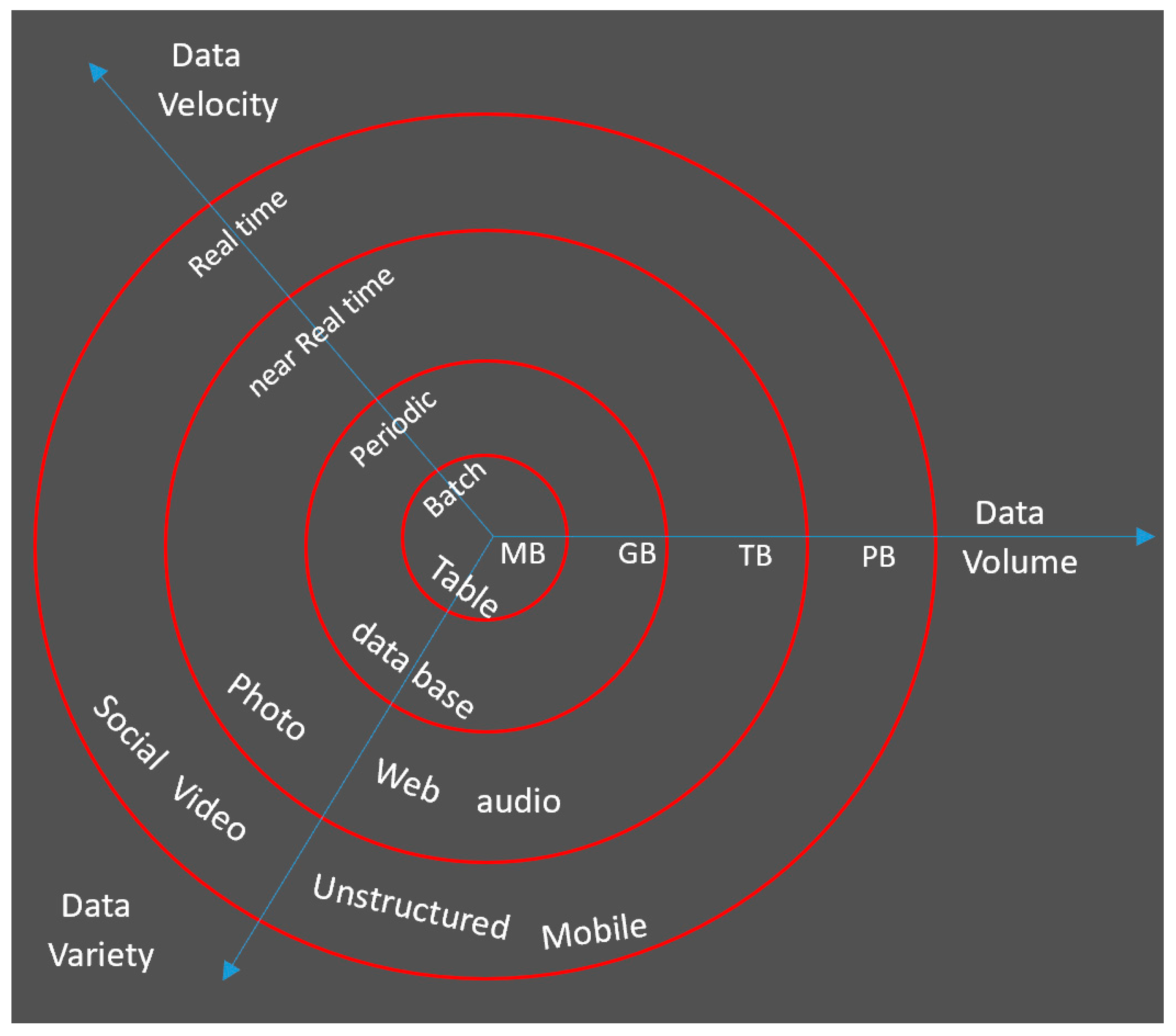
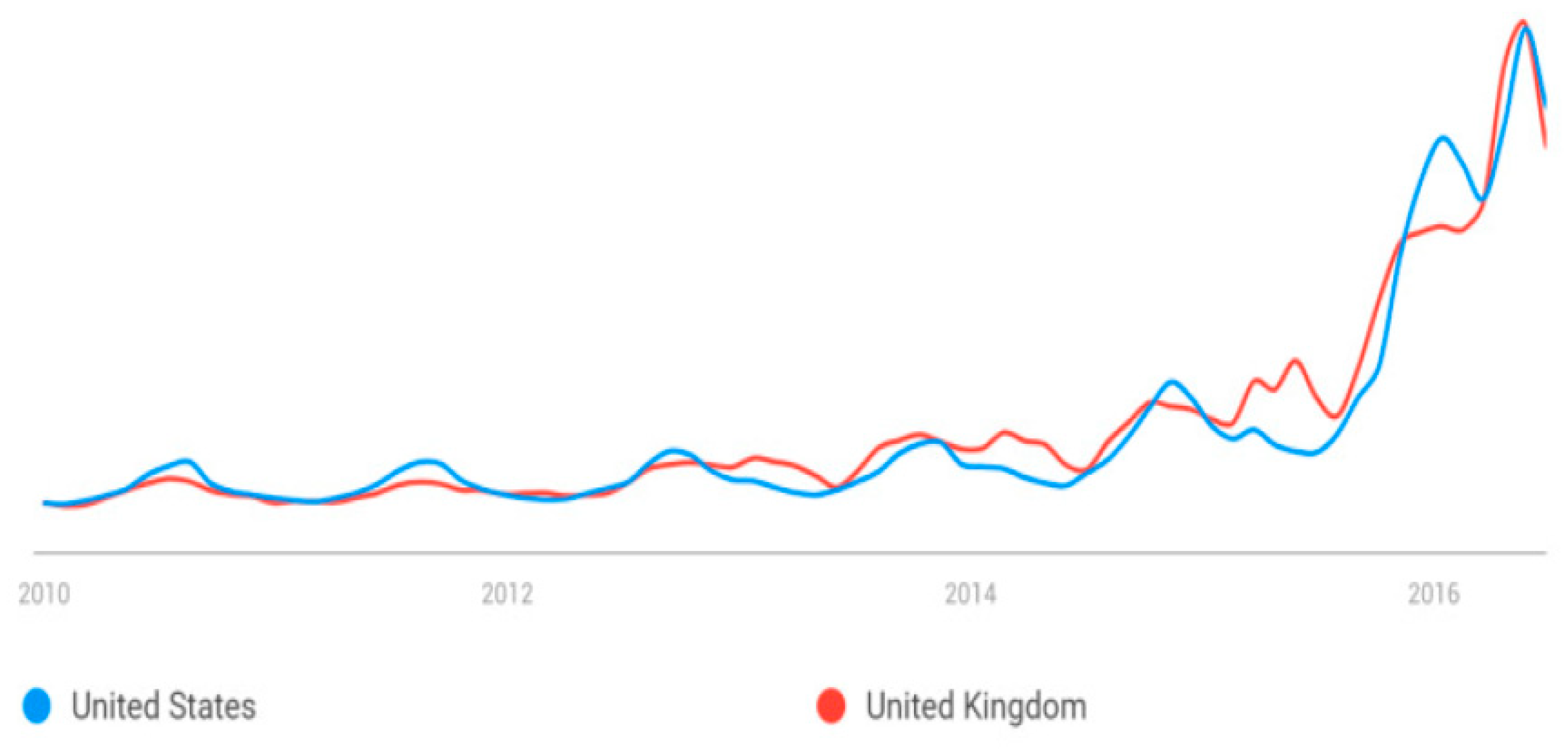

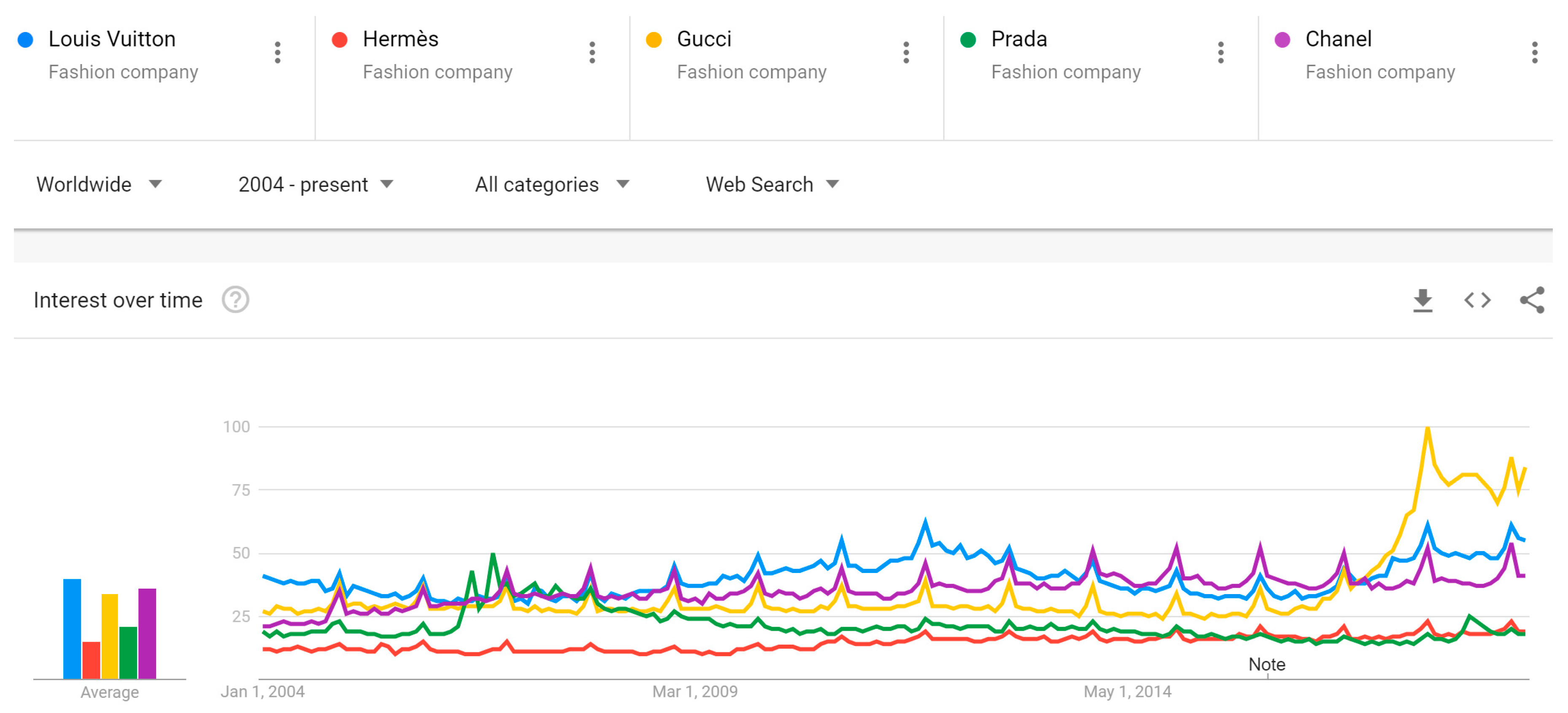


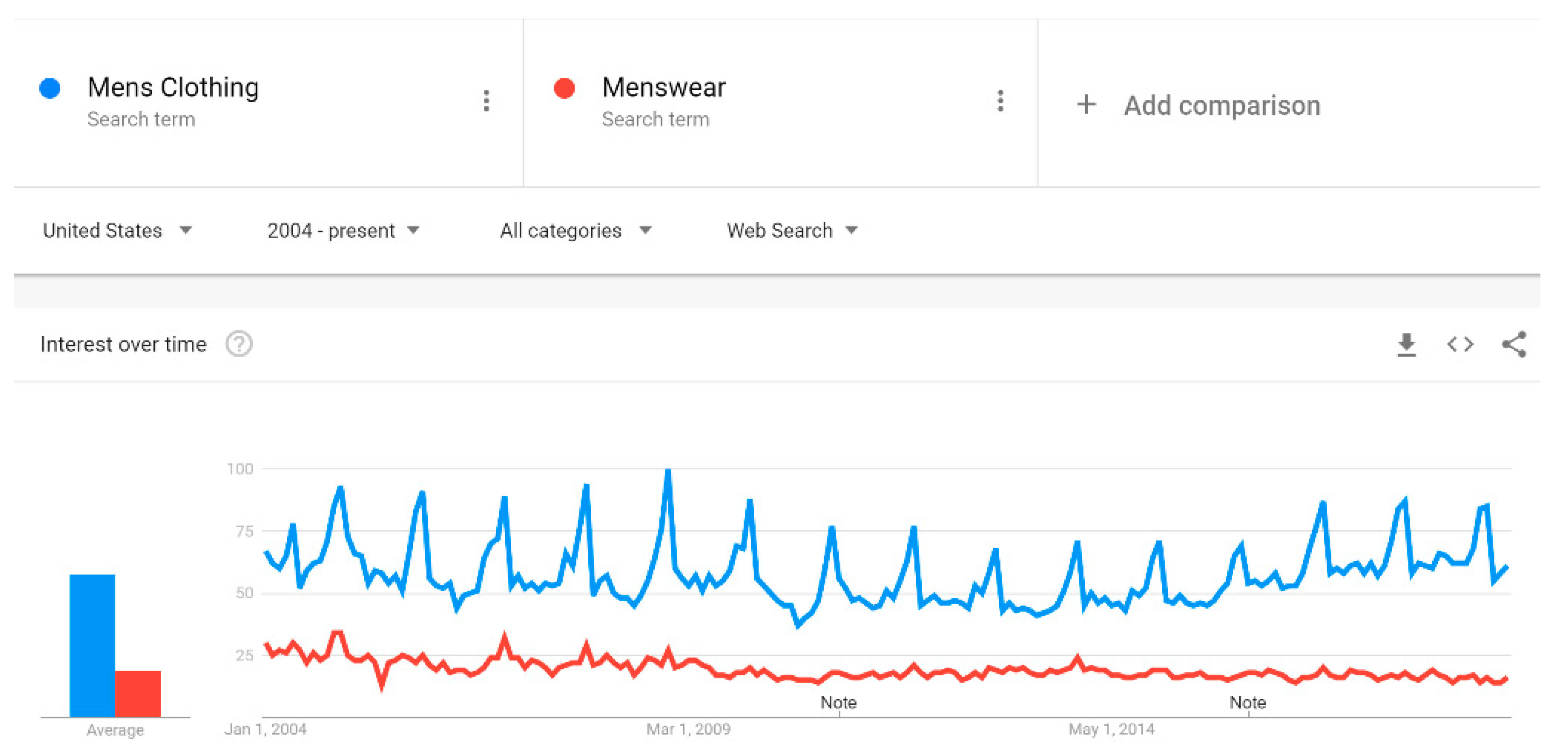

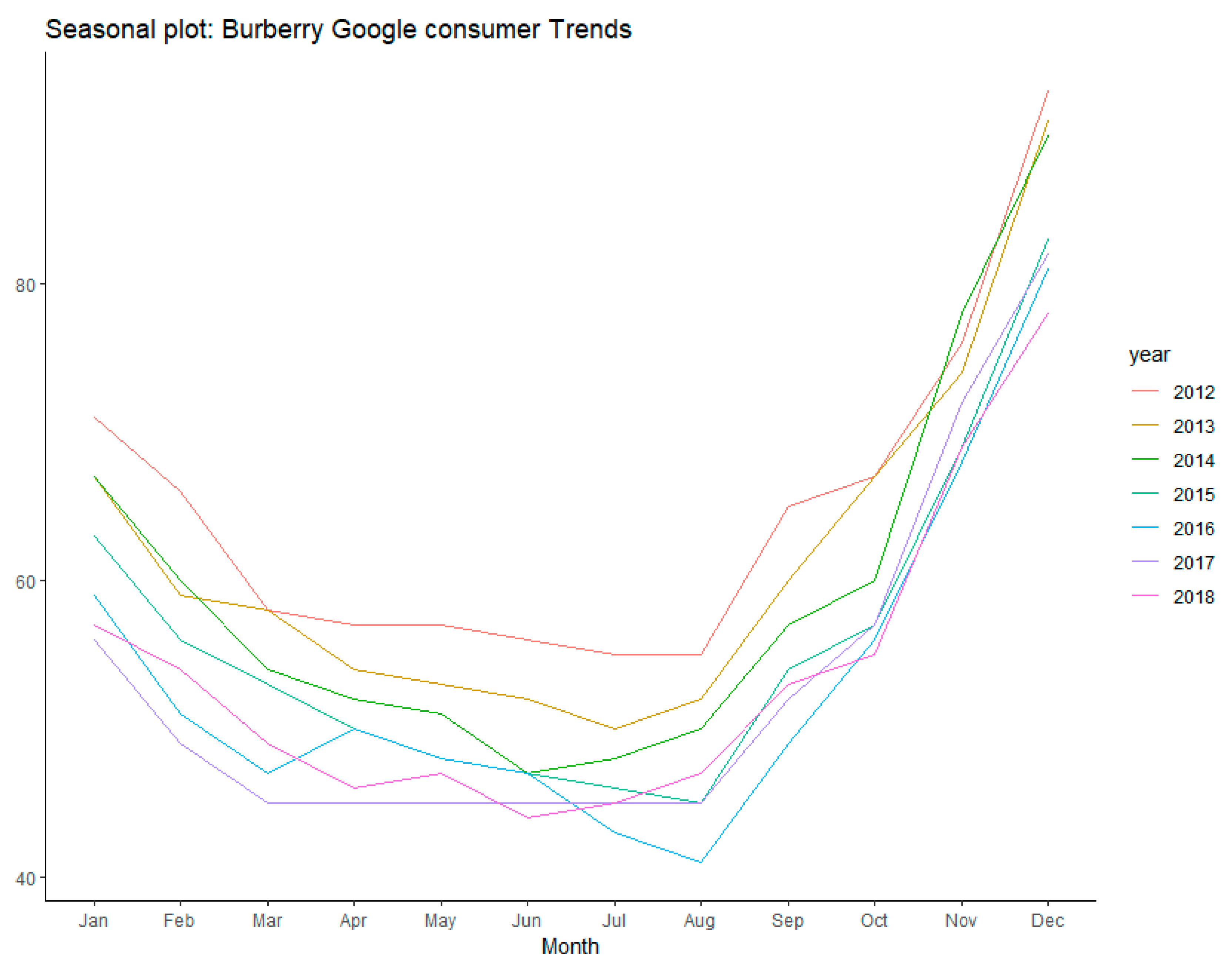
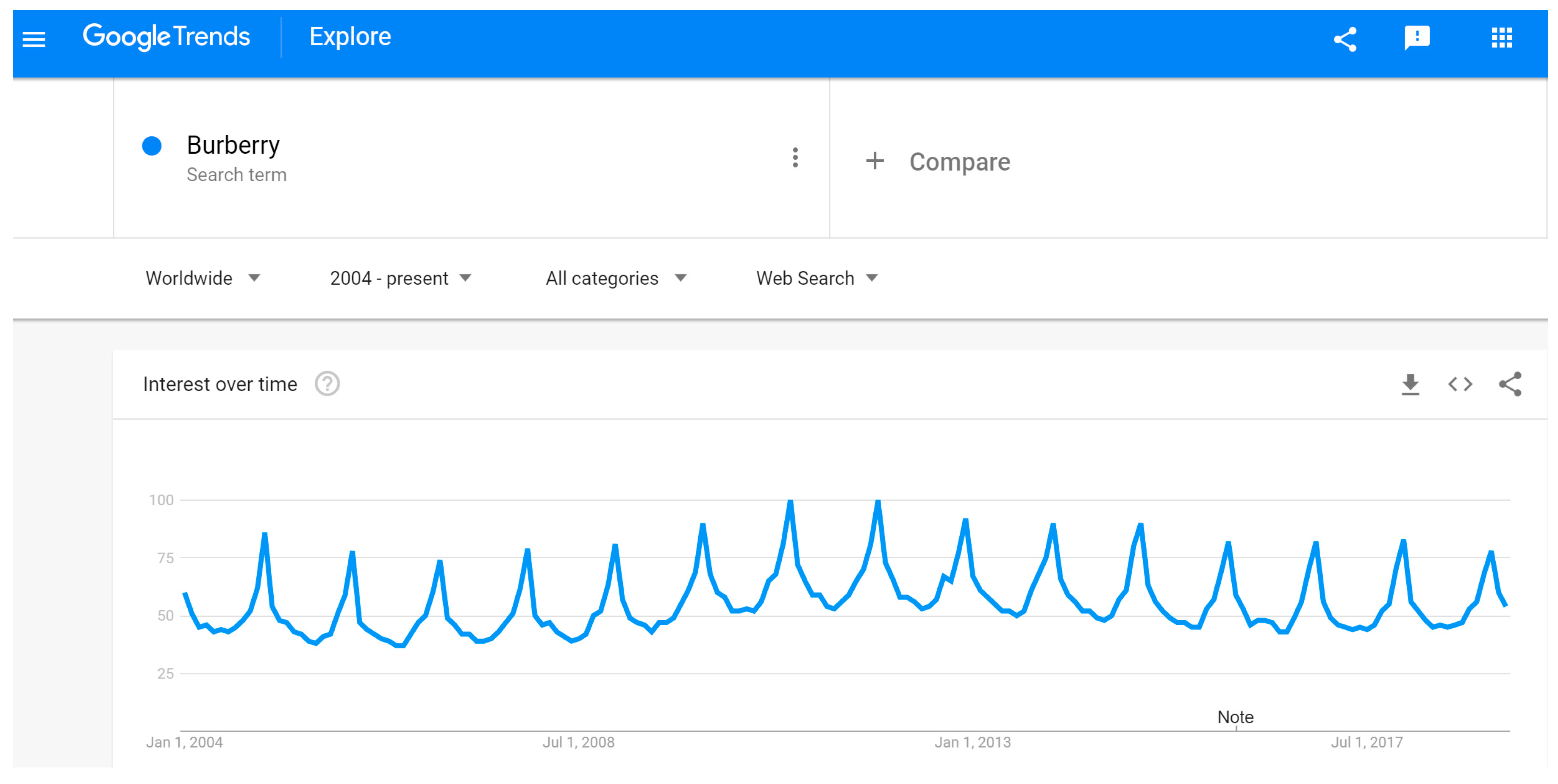
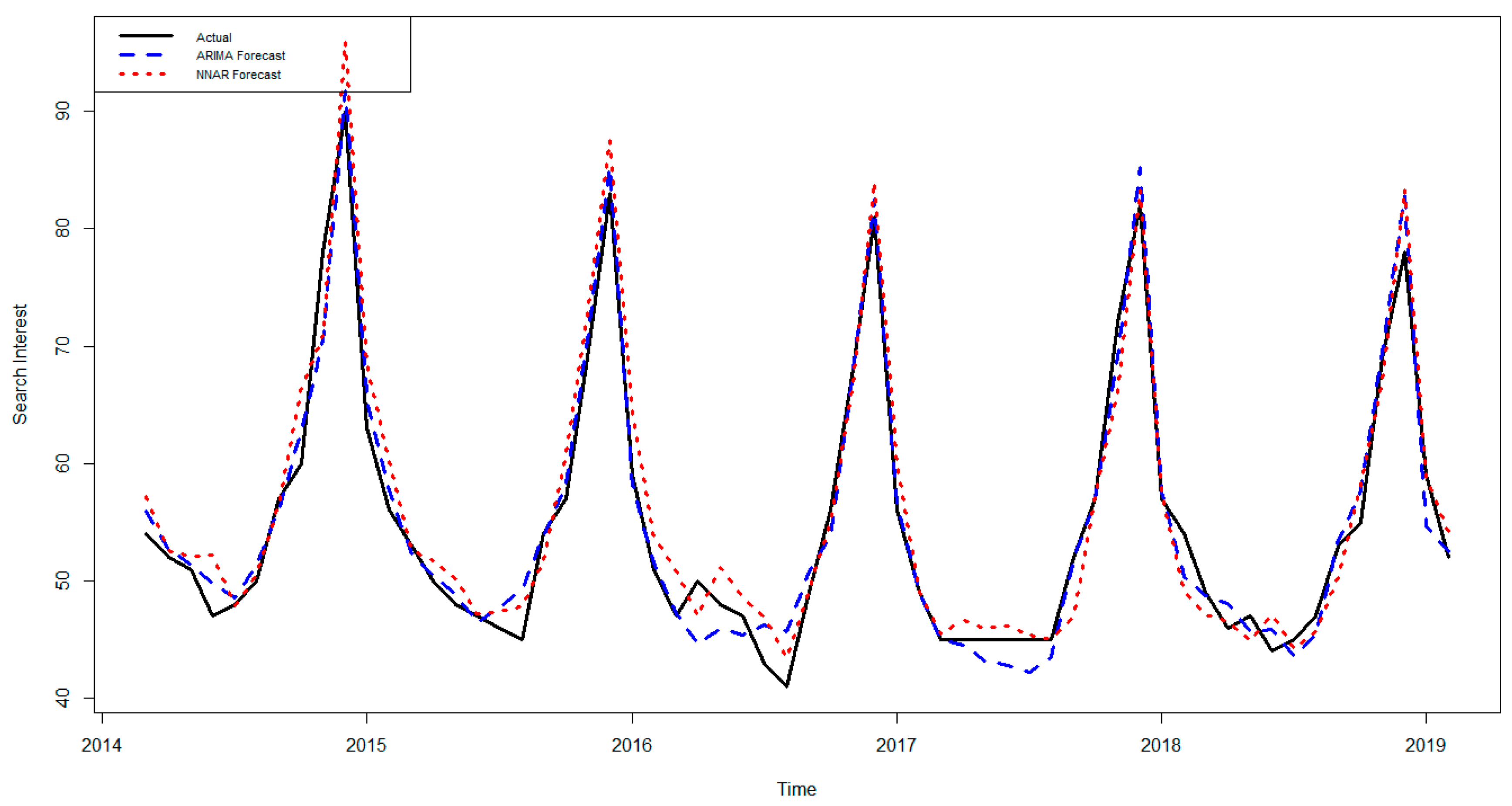
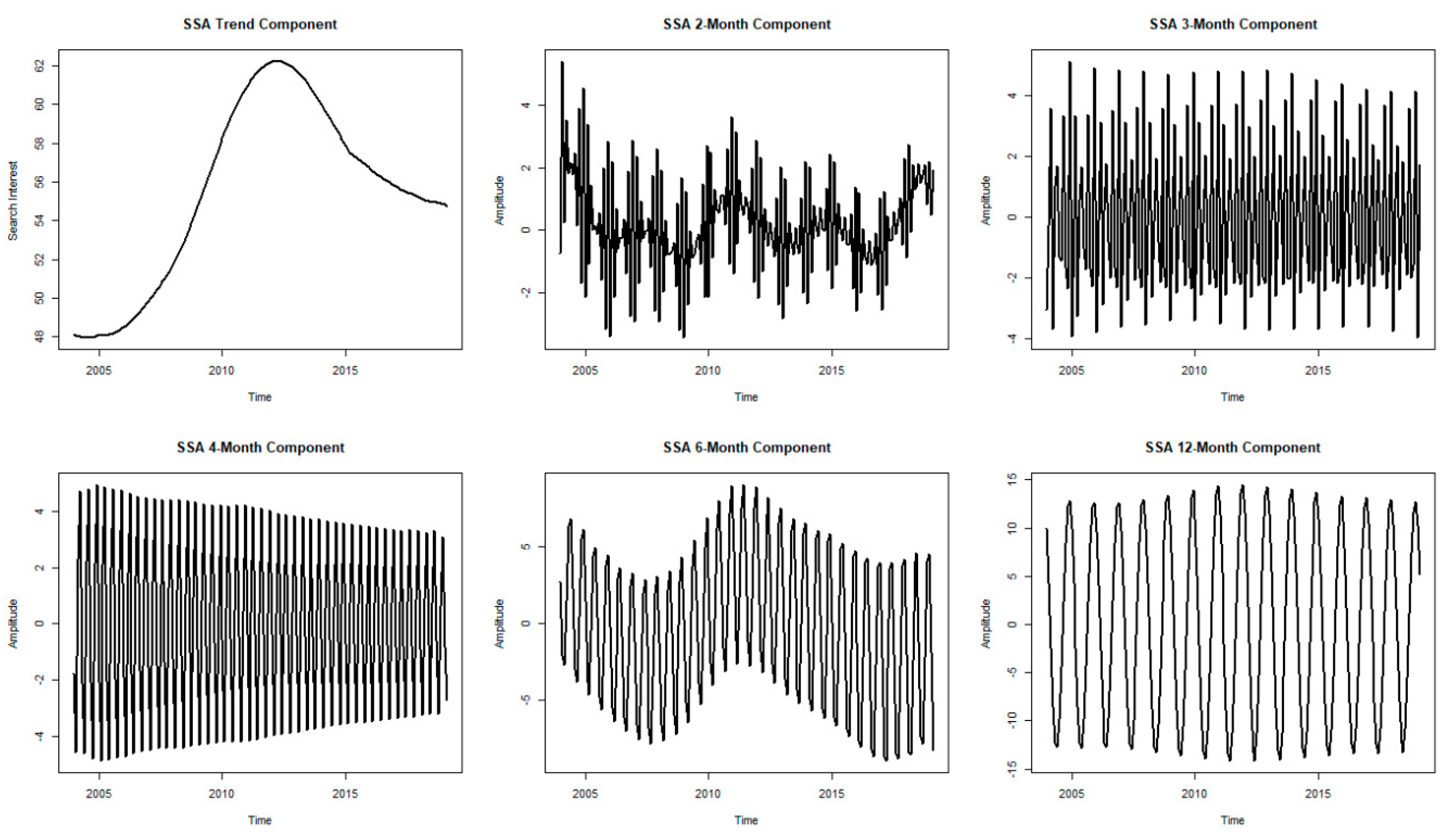
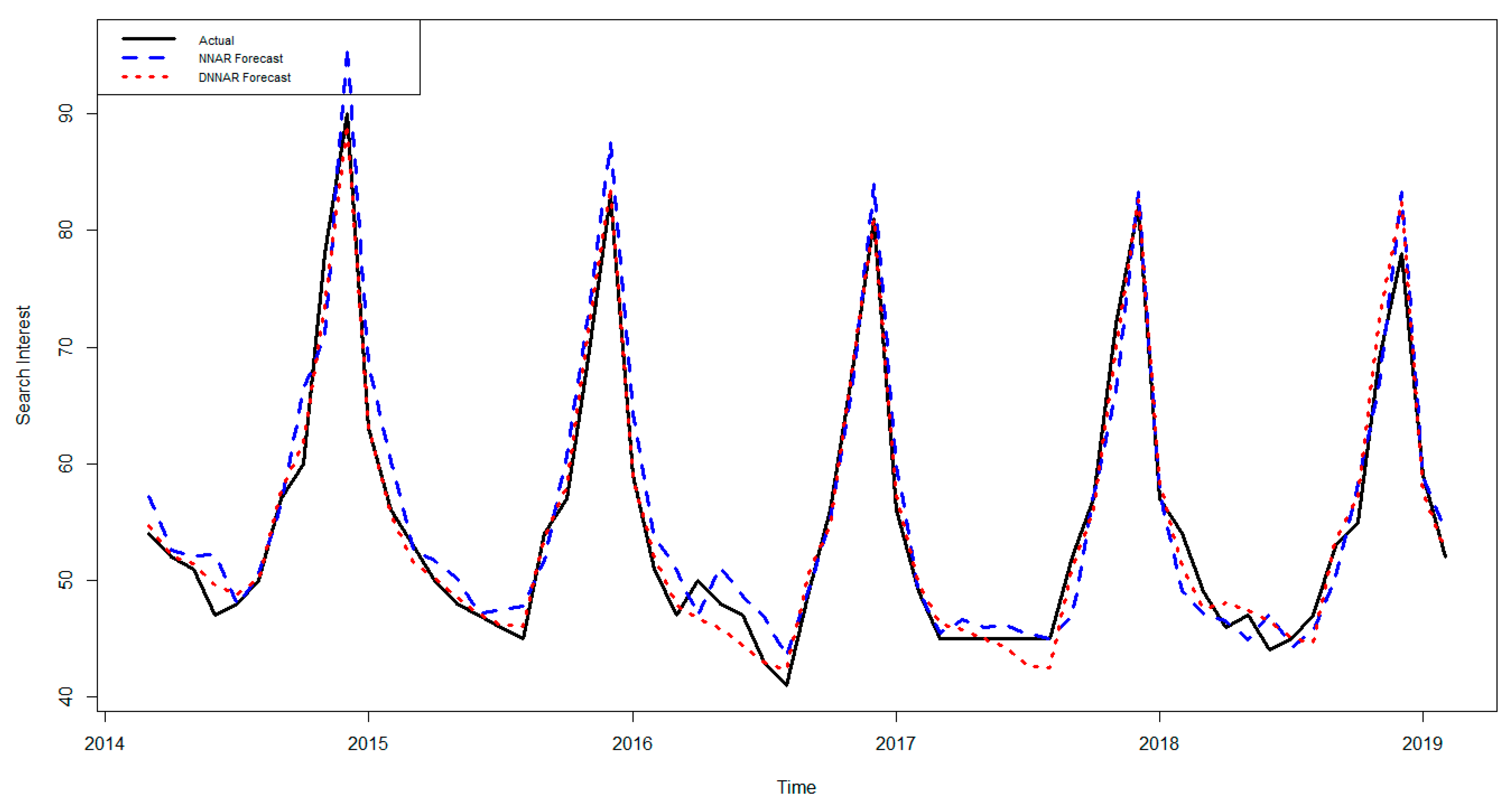

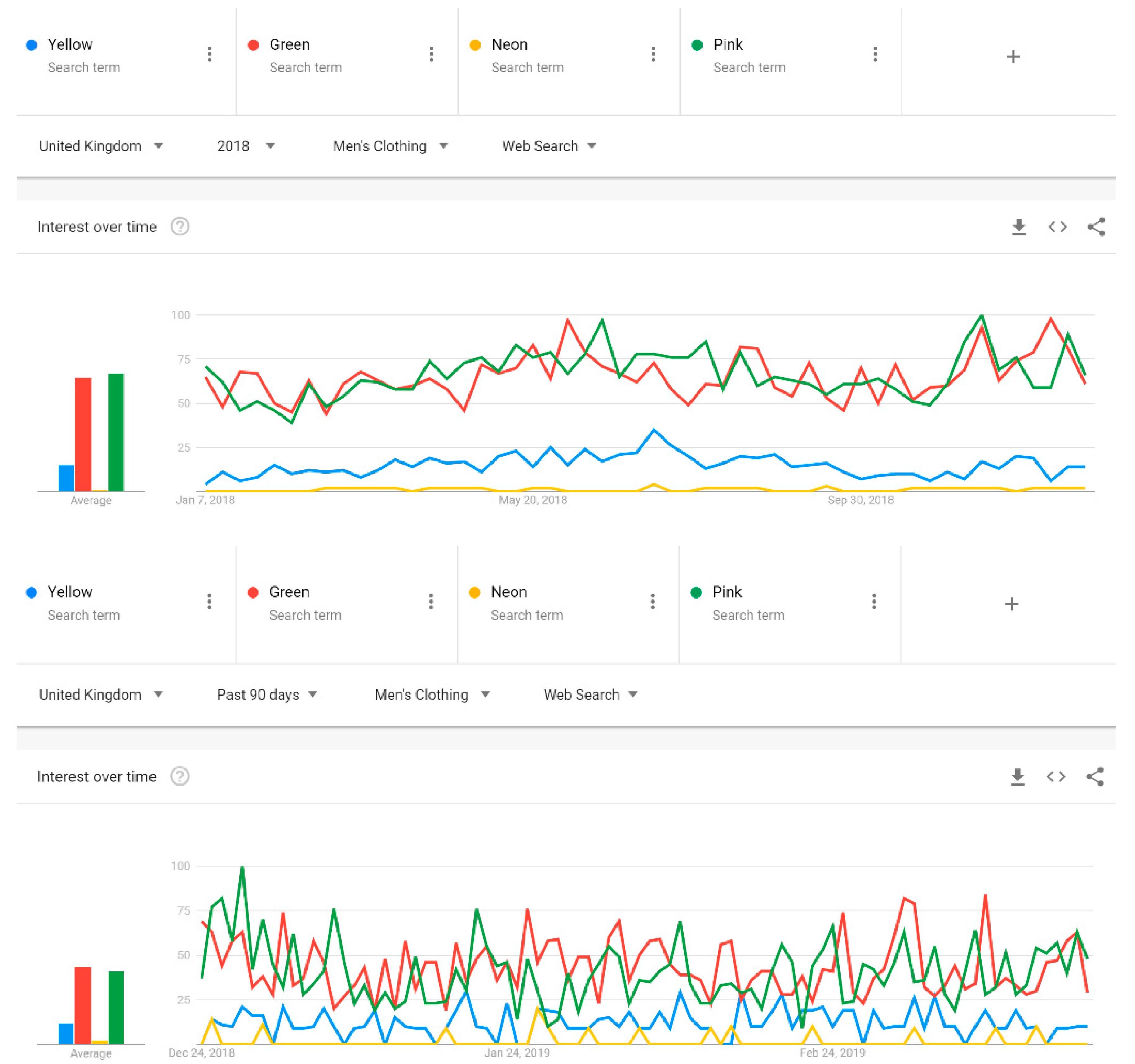
| Horizon | ARIMA | ETS | TBATS | NNAR |
|---|---|---|---|---|
| 1 | 2.30 | 2.52 | 2.42 | 3.08 |
| 3 | 2.76 | 2.90 | 2.75 | 4.13 |
| 6 | 2.99 | 2.98 | 3.07 | 4.06 |
| 12 | 3.53 | 3.30 | 3.50 | 3.79 |
| Horizon | ARIMA | ETS | TBATS | NNAR |
|---|---|---|---|---|
| 1 | 0.72 * | 0.65 * | 0.68 * | 0.53 * |
| 3 | 0.71 * | 0.67 * | 0.71 * | 0.47 * |
| 6 | 0.73 * | 0.73 * | 0.71 * | 0.54 * |
| 12 | 0.80 | 0.86 | 0.81 | 0.75 |
© 2019 by the authors. Licensee MDPI, Basel, Switzerland. This article is an open access article distributed under the terms and conditions of the Creative Commons Attribution (CC BY) license (http://creativecommons.org/licenses/by/4.0/).
Share and Cite
Silva, E.S.; Hassani, H.; Madsen, D.Ø.; Gee, L. Googling Fashion: Forecasting Fashion Consumer Behaviour Using Google Trends. Soc. Sci. 2019, 8, 111. https://doi.org/10.3390/socsci8040111
Silva ES, Hassani H, Madsen DØ, Gee L. Googling Fashion: Forecasting Fashion Consumer Behaviour Using Google Trends. Social Sciences. 2019; 8(4):111. https://doi.org/10.3390/socsci8040111
Chicago/Turabian StyleSilva, Emmanuel Sirimal, Hossein Hassani, Dag Øivind Madsen, and Liz Gee. 2019. "Googling Fashion: Forecasting Fashion Consumer Behaviour Using Google Trends" Social Sciences 8, no. 4: 111. https://doi.org/10.3390/socsci8040111
APA StyleSilva, E. S., Hassani, H., Madsen, D. Ø., & Gee, L. (2019). Googling Fashion: Forecasting Fashion Consumer Behaviour Using Google Trends. Social Sciences, 8(4), 111. https://doi.org/10.3390/socsci8040111







